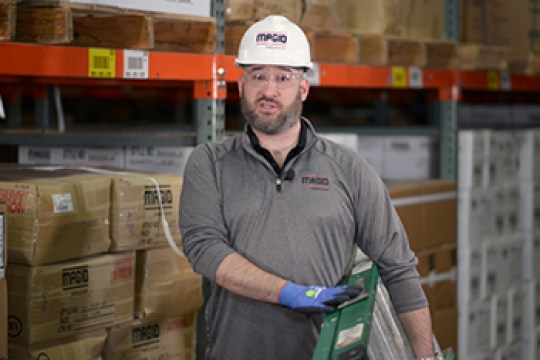
5 Ladder Safety Rules for the Workplace
Lots of jobs need a ladder at some point to get the work done. But incorrect ladder use leads to thousands of injuries every year and billions of dollars in expenses. The Consumer Product Safety Commission reports that over 500,000 people are treated for ladder-related falls every year. Even worse, the CDC says that over 300 people die from these falls annually.
Keep your workers safe with five ladder safety rules to promote ladder safety in your workplace:
1. Keep Them Informed of Ladder Safety Rules
The American National Standards Institute created a Duty Rating System that makes it easy for workers to understand what type of ladder is required for any job. Make sure your workers know that just because a ladder is tall or made of a certain material like wood, aluminum or fiberglass, doesn’t mean it’s strong. There is no relation between length of a ladder and its weight capacity!
All ladders are required to have a Duty Rating sticker on the side. Be sure your employees know where to look for this important information and post the ratings specifications in a prominent place wherever you store ladders:
| Rating Type | Duty Type | Load Capacity | Typical Use |
|---|---|---|---|
| Type III | Light Duty | 200lbs | Household |
| Type II | Medium Duty | 225lbs | Commercial |
| Type I | Heavy Duty | 250lbs | Industrial |
| Type IA | Extra Heavy Duty | 300lbs | Industrial |
| Type IAA | Special Duty | 375lbs | Industrial/Rugged |
2. Emphasize Common Sense & Safety First for Ladder Safety
At a minimum, your workers should immediately recognize a safety risk like a broken ladder rung or a slippery or uneven surface. Emphasize that safety and common sense always come first. If a ladder seems broken, don’t use it! If you don’t have three points of contact on the first step, you won’t have it when you’re up high either! Some jobs require two people or a type of ladder that may not be nearby. Reiterate that even if they need to find extra help or take the time to find appropriate equipment, they should always follow protocols to avoid potential accidents, injuries, or worse.
3. Provide the Proper Ladder for Every Job
You can’t entirely blame a worker for using the wrong ladder if the right one isn’t available. Never underestimate your employees’ tendency to improvise when they shouldn’t. Make sure every ladder in your facility is the correct tool for the job and the area. Take inventory of your company’s equipment and decide if you need extra ladders or better storage options to help your people make the right choices.
4. Lead by Example
It’s one thing to tell your workers why it’s beneficial to follow OSHA standards and safety protocols. But it’s another thing to show them with your own behavior. Time spent in training and toolbox talks won’t mean much if they think it’s okay to cut corners on ladder safety because they see you doing it.
5. Provide Ladder Safety Training & Reminders
Speaking of training, keep lessons top-of-mind with a combination of formal classroom instruction, safety reminder posters, and microlearning videos. Be sure to cover the most common reasons ladder accidents happen and showcase different safety rules for different ladder types. Repetition is the key to forming good safety habits!
Get free resources for ladder safety!
DOWNLOADABLE CLASSROOM TRAINING LADDER SAFETY REMINDER POSTER LADDER SAFETY MICROLEARNING VIDEO







